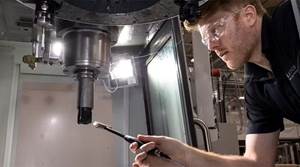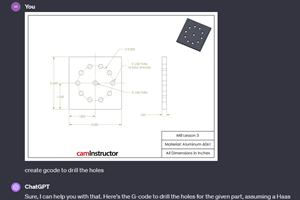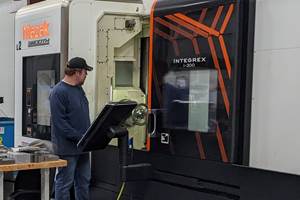Direct Connections To Fanuc Controls
The latest industry trend in this area will find us linking our CNCs via an Ethernet cable to the standard office local area network (LAN).
Share





For the aerospace, die or mold sectors that deal with long part programs regularly, reliance on serial DNC connections has always been a necessity. A new shop floor networking trend is emerging, however, and it is called direct CNC networking (or DCN). With high speed machining all the rage, CNC controllers need to break through the bottleneck of serial transmissions. The latest industry trend in this area will find us linking our CNCs via an Ethernet cable to the standard office local area network (LAN).
But that sounds easier than it is, mainly due to the proprietary architectures that have historically ruled in NC technology. Newer, open architecture controls are much easier to work with in this regard, but what are shops to do with their existing complement of controls? Memex Electronics Inc. (Burlington, Ontario), thinks they have an answer. According to company president Tom Gaasenbeek, Memex "intends to extend Microsoft's robust Windows NT platform into the industry standard CNCs, starting with Fanuc controls. The benefits of this system will include the ability to run programs of any length; the ability to load or execute part programs much faster; and the ability to implement machine tool monitoring systems to enhance plant floor productivity."
A DCN system enables much greater data flow in all directionsfrom almost instantaneous part program loading, to the extraction of useful SPC or machine monitoring information right from the control while it is running. This will open up the possibility of lightly attended or unattended machining operations, more flexible machining cells, and better ISO 9000 quality compliance ability. "In short," says Mr. Gaasenbeek, "the extension of common LAN technology to the shop floor will ultimately replace serial DNC as we know it today. In fact, DCN is in line with a growing trend towards open architecture controllers and shop floor systems. With all this change for the better imminent, industry experts and watchers alike are quoting Winston Churchill who once said, `This is not the end, nor even the beginning of the end -- rather it is the end of the beginning'."
The major stumbling block for automation extending to the control itself, has been the limited ability of CNCs to communicate with the outside world in real time. Having high performance motion control on the inside has not meant that CNCs necessarily communicate well on the outside. In response, Memex has created memory and network technologies that now enable Fanuc controls (from the Series 6 to present day controls) to open up to external systems. The first project was the emulation of bubble memory units found in the Fanuc 6, 9, 11 and 12 controls. The bubble is an electronic circuit board inside the CNC that provides the long-term, non-volatile memory for parameters, tool offsets and compiled part programs. The Memex Memory Engine (MME) was invented as a third party bubble clone.
Not only does the MME economically increase the CNC's memory size, it also speeds up the actual execution of the machine. For example, Wentworth Mould & Die (Hamilton, Ontario) found that the expanded memory approach has reduced cycle times by as much as 31 percent over serial DNC drip feeding. Another shop, Rochester Machine (Rochester, Michigan) found that they were able to achieve a 10-percent reduction in long production runs.
Unlike a bubble, the MME can also have a High Speed Loader (HSL) option board which provides access to the outside world. The HSL has additional memory and two high speed (115,200 baud) serial ports, one 19,200 baud test port and a parallel I/O port. Loaded in the HSL Flash ROM is the Memex Operating System (MOS), which enables direct G-code input with full Fanuc memory emulation. The MOS system also has a Dynamic Data Exchange (DDE) server inside, built around the Wonderware DDE tool kit. The DDE server capability has the potential to allow remote access to every block of data in the memory banks of the CNC.
Inherent in the MOS system are interesting new "virtualization" techniques. In essence, the HSL can allow the control to run a program of any size, at the highest possible speed, by using special caching techniques. Soon to be applied to even the latest controls, the Memex "NetCNC" concept combines the ability to run programs of unlimited length with the program restart and "editability" features so useful when running from memory.
Related Content
Can AI Replace Programmers? Writers Face a Similar Question
The answer is the same in both cases. Artificial intelligence performs sophisticated tasks, but falls short of delivering on the fullness of what the work entails.
Read MoreHow to Mitigate Chatter to Boost Machining Rates
There are usually better solutions to chatter than just reducing the feed rate. Through vibration analysis, the chatter problem can be solved, enabling much higher metal removal rates, better quality and longer tool life.
Read MoreCan ChatGPT Create Usable G-Code Programs?
Since its debut in late 2022, ChatGPT has been used in many situations, from writing stories to writing code, including G-code. But is it useful to shops? We asked a CAM expert for his thoughts.
Read More5 Tips for Running a Profitable Aerospace Shop
Aerospace machining is a demanding and competitive sector of manufacturing, but this shop demonstrates five ways to find aerospace success.
Read MoreRead Next
Machine Shop MBA
Making Chips and 91ÊÓƵÍøÕ¾ÎÛ are teaming up for a new podcast series called Machine Shop MBA—designed to help manufacturers measure their success against the industry’s best. Through the lens of the Top Shops benchmarking program, the series explores the KPIs that set high-performing shops apart, from machine utilization and first-pass yield to employee engagement and revenue per employee.
Read MoreLast Chance! 2025 Top Shops Benchmarking Survey Still Open Through April 30
Don’t miss out! 91ÊÓƵÍøÕ¾ÎÛ's Top Shops Benchmarking Survey is still open — but not for long. This is your last chance to a receive free, customized benchmarking report that includes actionable feedback across several shopfloor and business metrics.
Read MoreAMRs Are Moving Into Manufacturing: 4 Considerations for Implementation
AMRs can provide a flexible, easy-to-use automation platform so long as manufacturers choose a suitable task and prepare their facilities.
Read More






















